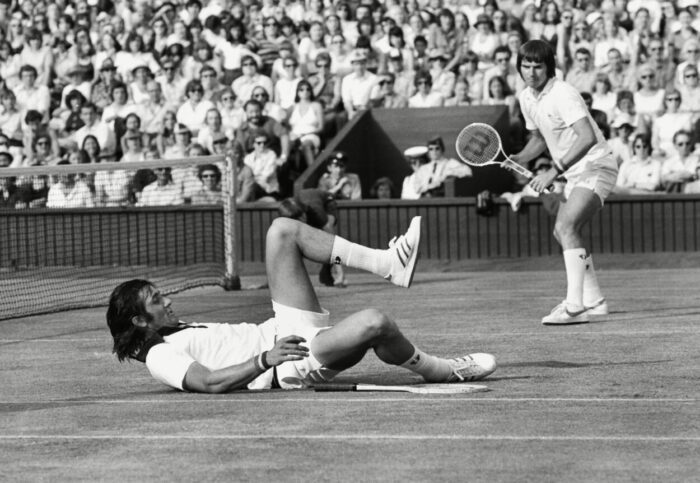The sport of tennis has had its personalities, especially in its peak boom era of the 1970s. Yet none was as enigmatic and mercurial as the man known as “Nasty”: Ilie Năstase, the lithe, handsome, almost preternaturally talented Romanian whose electric, unpredictable style of play stood him apart from the field and won him legions of adoring fans. His talent took him to Grand Slam singles titles at the U.S. Open in 1972 and the French in 1973; it was, though, his temperament which overshadowed his talent, giving him the nickname that adorns this superb new documentary about his life and career: “Nasty,” he was known for his petulant on-court tantrums.
The documentary Nasty, set to premiere at Cannes Film Festival later this month, co-directed and produced by a Romanian crew of Tudor Giurgiu, Cristian Pascariu, and Tudor D, Popescu with international support, does its complex subject justice. Nasty explores Ilie Năstase’s life in full, from his origins as a young athlete in Romania to his storied, complex tennis career, with plenty attention too to his considerable sex appeal and his international celebrity. The documentary is replete with truly impressive archival footage—much of which I’d never seen before even as an ardent fan of the sport and the era—and fleshed out with interviews from rival Stan Smith (himself the recent subject of his own documentary, Who Is Stan Smith?), doubles partner and co-enfant terrible Jimmy Connors, Boris Becker, John McEnroe, Bjorn Borg, Billie Jean King, and, most importantly, his mentor and Team Romania Davis Cup partner Ion Țiriac.

Nasty does not take a simple chronological approach to its historical subject. Doing so would likely short-shrift Năstase’s playing career, which took him to dizzying heights at its apex but did not last anywhere nearly as long as that of most of his rivals. Instead, the filmmakers employ a more analogical approach, with separate sections of the film dedicated to exploring Năstase’s upbringing, his talent, his accomplishments, his legendary tantrums, his romances (to put it one way, if you know what I mean), his controversies, and his celebrity before concluding with a flashback to one of Năstase’s greatest on-court failures, the 1972 Bucharest Davis Cup Final versus the United States.
The organization can feel a bit repetitive, especially when each section of the film gets its own (well-crafted) montage sequence, but its strength is an ability to delve into its star’s enigmatic, sometimes inexplicable psyche in depth. Where his rivals worked at the game, Năstase played at it with the effervescent joy of a seemingly eternal youth, using a mix of courtcraft and guile, cannily imparting unpredictable spins and angles to confuse and even bedazzle his opponents. At its best, it was an improvisational, ineffably gorgeous display. It could be rendered moot, though, by blunt power (Smith, Connors), steely consistency (Borg) or by Năstase’s own inner demons.
Năstase’s tantrums were legendary. Even while coasting to an easy victory he might take to mocking his opponents, bickering with the crowd, complaining about conditions, or berating officials. If his joie-de-vivre playing style was his superpower, his own unpredictable temperament was his Kryptonite. Once he behaved so badly the normally imperturbable Arthur Ashe walked off the court in disgust; then the umpire defaulted Năstase. It was the first match in the sport’s history neither man won. Smith’s longtime doubles partner, the feisty Bob Lutz, is on-screen threatening to punch the Romanian in the face if he tries any of his antics against him.

Yet for all his on-court Nastiness, Năstase was a man nearly every player—and throngs of crowds, especially women—adored. After a legendary tantrum got him temporarily defaulted and the crowd nearly in a riot when competing against McEnroe at the U.S. Open in 1979, minutes after the match he was inviting his young opponent to a night on the town. With his movie-star looks, flowing dark locks, and gentle off-court manner, Năstase was a hit with the women (estimates have him having slept with thousands) and seventies swimsuit supermodel Cheryl Tiegs gushes about his bedroom prowess here.
Nasty takes all of this into its account and more. There is some attention to his repulsive comments about Serena Williams in 2017, though less to other, less racist but no less appalling, behaviors in recent memory. Pam Shriver, who says Năstase pestered her throughout her teen pro career with questions about her virginity, was among those not interviewed for the film. Năstase’s age, upbringing, and personality have at times allowed him to speak his mind a little too freely for his own or others’ good and the rebuke has been much louder elsewhere than in this documentary.
Nasty concludes with what was a defining moment in his career, a gutting loss to the U.S. team led by rival Stan Smith at home, in Bucharest, in the 1972 Davis Cup Final. Năstase was at the very peak of his prowess at that moment and eager to avenge an agonizingly close five-set final loss to Smith at Wimbledon earlier that summer. Today, with the Davis Cup competition no longer a vital force in the sport, it may be difficult to recall a time when the contest was paramount, equal to if not sometimes more important than the Grand Slam singles events themselves.
To provide a little context, the Davis Cup was the one competition that placed tennis’s individualist competitors, all of them usually playing for their own self-interests, on a team. And that team carried the weight of their nation. In tiny Romania, to compete for such a prestigious title was a remarkable opportunity. The Cup trophy itself, more than three feet tall and weighing over 200 pounds, was flown to Bucharest for the championship tie, as crowds lined up to gaze at it and throngs anticipated the event, the first such in its country’s history.
The weight of the country—and its ruling party—was heavy on the competitors. “As the Party has instructed, we hope to win this Davis Cup,” said Năstase’s teammate Țiriac with no trace of irony. The Romanian Federation watered the soft red clay courts to slow down Smith and the U.S. team and installed a cadre of local linespeople to make sure any close calls benefited the home team. There seemed no chance the U.S. team could pull off an upset on the road.

Nasty charts this episode in tennis’s rich history with incredible detail and remarkable footage culled from different sources. There is richly detailed black-and-white film detailing the doubles contest between Năstase and Țiriac, who were reduced to bickering between themselves as they buckled under pressure, and the U.S. team of Smith and Erik von Dillen. But there is also grainy colored footage of the disconsolate crowd and littered stadium as it empties, the Romanian team’s chances withering away like discarded debris in the wind. The pressure on Năstase and Tiriac—from the crowd, the country, and the Communist Party—was too immense to bear.
Here’s where Nasty sets itself apart from many a sports documentary: it understands that sport is the most human of subjects, that the individual psyche can be as fragile as the body can be strong. Tennis history may record Ilie Năstase as a two-time Grand Slam singles champion and the first-ever men’s player to hold the computer-based Number One world ranking. But Năstase will also be known for his incendiary temperament and childish tantrums. Nasty, with its detailed and compassionate study of its enigmatic subject, shows us that there is more to a competitor than merely competition. In his day, Ilie Năstase was simultaneously revered and reviled, but even now, fifty years later, he is a subject that still commands the camera—and our collective attention.




